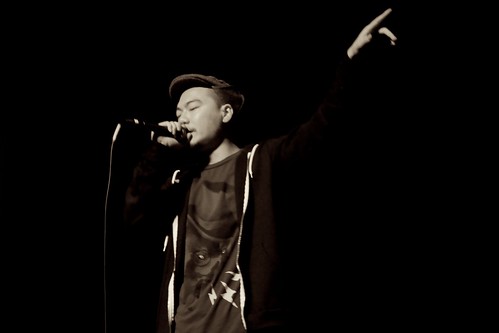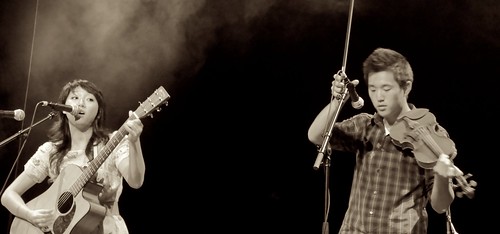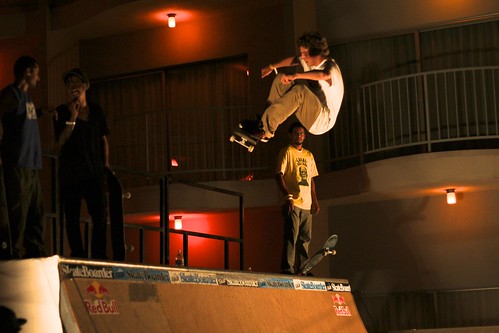I like to feel scholarly sometimes.
American Studies 252 - Black Social Movements
Essay #1.
Promt: What was T. Thomas Fortune’s vision for America, particularly for the plight of black and white farmers? How did the U.S. Constitution, the Magna Carta, and the Communist Manifesto inform his ideas? [Obviously, Fortune makes passing reference to these documents, so it is up to you to extrapolate his ideas from the text.] What movements in the late 19th century took up his agenda and why did they fail?
In a country torn apart by deep-rooted racism and the “peculiar institution” of slavery, the 19th century African-American encountered radically changing time periods in the face of an oppressive society. From the outbreak of the Civil War to an era of Reconstruction for the defeated South, T. Thomas Fortune has witnessed the vices and plight of the African American in the course of pivotal points in U.S. history. While the Northern industrialists and Southern planters shared a post-Civil War vision for reconstructed America revolving around cheap docile labor, Fortune had his own revolutionary vision for the newly freed African Americans. His vision in Black and White transcends racial lines between the African Americans and Whites, and instead perceives the conflict to be one of socioeconomic class. Speaking out against injustices on land, education, political oppression, and labor of the hour, Fortune finds the cause of the laboring man “the same in all sections, in all States, in all governments [and] all the world” (108) and writes Black and White for the “common cause of a common humanity” (108). On the aforementioned issues, he advocates, respectively, common ownership of land, universal fundamental education, political independence by means of universal suffrage, and the unity of labor against an unjust capitalist system. At the heart of Fortune’s vision for America is a theme of interracial unity and can be reflected in his influences from the U.S. Constitution and the Communist Manifesto; furthermore, without this central component of interracial cooperation and class-conflict, his vision, as shown through the late 19th century movements that took up his convictions, ultimately fails.
On the subject of land reform, Fortune’s main vision for this interracial working class is the adoption of common land as a commodity and the abolition of land as private property. Interracial cooperation against this economic concern is crucial in his image of land reform; he believes both black and white farmers had an unalienable right to land for it was “one of the natural elements…without which life could in no wise be sustained” and upon which “[grew] those things which nature intended for the sustentation of the physical man” (136).
Indeed, the issue of land reform surpasses any racial lines and shifts the focus of the question to the economics aspect. A monopoly on land means farmers of both races struggling not only to pay land tenants but also to merely survive and feed their families; this leads to the poor conditions of the South, while it also increases the wealth of the land-owners with minimal labor. Fortune opposes these powerful land-aristocrats because “they thrive” while “all the rest of humanity…[revels] in poverty, vice, and crime” (140). Thus, the concept of land as common property would give “the same opportunity to the great laboring classes, who earnestly desire to make a living but to whom the opportunity is cruelly and maliciously denied” (Fortune 140). Without common access to the soil, the laboring classes of blacks and whites share the common enemy of the land-monopolist and must ultimately work past racial differences.
Fortune’s call for universal laborers mimics the Communist Manifesto’s universal cry for “working men of all countries [to] unite” (Marx 32). Similarly, Fortune’s idea of common property is shared in Marx’s Manifesto; in fact, the theory of the Communist party “may be summed up in the single sentence: Abolition of private property” (Marx 14). Both Marx and Fortune speak against the injustices of the upper class, which controls the methods of production, in this case, land, in support of the “proletariat.” The common land reform question is even raised in the English Magna Charta from centuries before; the 13th century citizens instated that all private forests to be “disafforested;” furthermore, the common ground for equal opportunity stems in Fortune’s belief in the U.S. Declaration of Independence and the Constitution that “All men are created equal” and are “under equal protection from the law.” Thus, looking at Fortune’s vision for equal opportunity in common land, one can see his influences by the aforementioned documents.
The idea of racial unity behind the common ownership of land is accompanied by Fortune’s same idea of racial unity behind labor. This is one of Fortune’s most directly explicated visions – that the economic oppression of laboring classes causes a need for the laboring blacks and whites to overthrow the capital-ruled society and distribute wealth more equally. By illustrating that “the condition of the black and white laborer is the same and that consequently their cause is common” (109), Fortune aims to change the capitalist environment that drives the labor of the majority to provide for the few. He speaks against competition between black and white farmers and instead asserts, “[the] intelligent, the ambitious and the wealthy men of both races will eventually rule over” without invidious regard to race or previous condition” (110).
Indeed, Fortune’s emphasis on the interracial future of labor is clear; capitalist competition, in its drive for the maximum production at the minimum cost, ultimately “reduces the wage of the great consumers as well as producers” (104). Slavery illustrates the immorality of exploiting workers at minimal cost; yet after its abolition, it has persisted in the economic exploitation of “wage-slavery.” This capitalist machine accumulates wealth in the hands of a few, and leaves little for the laborers. Thus, the black farmer and the white farmer “should unite under the one banner and work upon the same platform of principles for the uplifting of labor, the more equal distribution of the products of labor and capital” (108).
Again, it is evident that desegregated labor was at the heart of Fortune’s agenda; and this, again, has its roots in the Communist Manifesto. The Communist Manifesto advocates an agrarian socialist society with equal wealth and opportunity for all, which is essentially what Fortune argues for. Capitalist economy has a tendency to undermine, and therefore eventually eliminate, racism; and after the smoke has cleared on the controversy of race, what is left shall be the class struggle of poor versus rich. After all, as Marx affirms, “[the] history of all hitherto existing society is the history of class struggles” (3).
On the question of the political role of the African American, Fortune champions harmony between the two races by calling for the black’s assimilation into a traditionally white political society. Although the 13th, 14th, and 15th amendments guaranteed the ballot to all males on paper, they held little power in enforcing these ideals. Here, it is important to note Fortune’s bitter view of the Constitution as a non-living document.
Fortune’s reference to the Constitution as “our Magna Charta” illustrates how significant he perceives the document to be (at the time the English Magna Charta still stood for the righteous sentiment of government by the people for the people). It is the disparity between his strong belief in the Constitution’s ideals and its inability to enforce them that makes his tone bitter and ironic. In regards to slavery, however, Fortune mocks how “the most broad and liberal compact” can be used to shield the slave owners “but yet cannot shield a black man, a citizen and to the manor born, in any common, civil or political right which usually attaches to citizenship” (7). Of what use is a guarantee of equal protection under the law if it is not enforced? This document, which institutionalized the enslaved labor of millions of human beings, betrayed the ideals of equality that it had stood for. Thus, although political equality for African Americans cannot be achieved through America’s Magna Charta, it is nonetheless important to note its influence in Fortune’s beliefs in the very ideals it fails to uphold.
Returning to Fortune’s vision for political equality, he endorses “the harmony of sentiment between the blacks and whites of the country” as “natural and necessary” (71). Hence, the colored man of the South “must cultivate more cordial relations with the white men of the South” (78). In turn, the white men would ideally acknowledge the colored man as an independent force in Southern politics. To attain such acknowledgement as a true independent voter, Fortune sought to eradicate party affiliations by telling blacks to affiliate with “any faction which will ensure him in his right to ‘life, liberty, and the pursuit of happiness’” (68). Again, one can note the influence of the Founding Father’s ideals on Fortune’s beliefs. Furthermore, he emphasized the need for intelligence and knowledge on the political system of government in order to create a true independent voter. And when African American votes lie on both sides of the political spectrum, racial divisions among politics will have been eliminated, and only then will the African American vote truly count.
With race out of the picture of politics, Fortune’s image for black and whites is comprehensible: that the “best interests of the race and the best interests of the country will be conserved by building up a bond of union between the white people and negroes of the South” (71). Since the interests of the two are essentially the same, future legislation affects them both, and African Americans should firstly assimilate as American citizens and equal recipients of the law. Thus, as Fortune states, “[to] preach the independence of the colored man is to preach his Americanization” (76); he must put his nationality before his ethnicity and join his fellow Americans, regardless of race.
Finally, Fortune’s theme of interracial unanimity is mirrored in his call for universal education. The role of education is vital in Fortune’s post-Reconstruction era, and he believed the government should provide it for all; it is the government’s responsibility “to see to it that its citizens are properly prepared to exercise wisely [their] liberties” (36). (Fortune’s reverence to the principles behind the Constitution is yet again reflected in his belief that “[the people] should be instructed in the language which is the medium through which to interpret their grand Magna Charta” (37).) Indeed, without education, the ballot is meaningless. Fortune not only speaks specifically for the blacks, but the poor whites, as well, who have no schools, appalling literacy, and horrible poverty, who are also men the same as their racial counterpart. Therefore, Fortune denounces the segregated school system that undermines his vision of racial unity. Not only does it unjustly demoralize the students, in their supposition that one is better than another, the system maintains twice its expenditures for the two sets of schools, “simply to gratify a prejudice” (41).
What Fortune suggests instead, is universal industrial education, education in a specific trade. If education prepares one for work to be done, then men should be taught with specific reference for that work. In his interracial proposal for education, Fortune asserts, “What the colored boy, what all boys of the country need, is industrial not ornamental education” (55). Here, he finds a social injustice as dealt to the African American population, and then incorporates his interracial standard for the Whites, as well, in dealing with the injustice.
Undeniably, Fortune’s concept of interracial unity is so crucial that the movements inspired by his beliefs eventually fail because they lack this unity. For instance, the National Colored Farmers’ Alliance, founded in 1886, took up the principles of T. Thomas Fortune and Booker T. Washington with an agenda that advocated economic progress for political unity. When collaborating with the white Farmer’s Alliance, they became divided over a Federal Elections Bill; and subsequently the white Farmer’s Alliance opposed one of the Colored Farmer’s strikes for the increase of wages of cotton-pickers. These failures consequently led to the decline of both movements. This is a prime example of how Fortune’s interracial unity was not achieved, and, as a result, the movement encounters failure.
A similar social working movement, the Knights of Labor, neglected the segregation of the South and excluded Chinese workers. The disparity and inequality of race ultimately resulted in the party’s decline in the 1890’s, too. Out of this grew the Populist movement, which, too, failed due to divisions within the party. Although initially speaking of setting aside between poor whites and blacks, their fusion with the Democratic party in the 1900’s introduced white supremacists, such as Thomas E. Watson, and a call for disfranchisement of the black vote. Here, these movements could not overcome the deeply rooted racial differences that Fortune believed would, in the end, disintegrate.
The lack of interracial unity was yet again the downfall of a political advancement in Wilmington, North Carolina. Although the Republicans and Populists defeated the Democrats for control of the state’s House and Senate seats in 1892 and even elected an African American to Congress in 1896, the Democrats eventually regained power. By appealing to whites’ racial fears, the Democrats won over white Populists to the ideas of White Supremacy and destroyed this interracial alliance.
Even the movement sparked by Marcus Garvey was undermined by racial conflict. While he initially gained followers because his advocated racial unity, his progress was eventually hindered because he made the fundamental assumption that those of colored skin shared his common beliefs; this assumption undermined racial equality for he presumed an entire race to possess his perspectives on the mere basis of their skin color. Once again, interracial agreement is key in Fortune’s proposal for America; without this, Fortune’s suggestions prove impossible to sustain.
Thus, interracial unity is central to T. Thomas Fortune’s vision and can be illustrated in his propositions for land, labor, politics, and education; one can see the influence of this essential component in the U.S. Constitution and Communist Manifesto. Indeed, the book that is the brainchild of his beliefs is titled Black AND White, with emphasis on the conjunction “and,” which connotes togetherness of the two people. As a book centers around its title, Fortune’s beliefs gravitate around this concept of harmony between Black and White. The failure of late 19th century movements that attempted to take up his agenda serves as direct evidence that the interracial unity they lacked was a key factor. Fortune’s ideas, as well as those behind Marx’s Manifesto, were radically ahead of his time – that “black and white citizens of the South must alter the lines which have divided them since the close of the war,” and that they are “essentially, one people [with] a common origin…[living] in the same communities, pursuing identical avocations, and subject to the same fundamental laws” (84). And although his vision for an agrarian society and the death of capitalism was never attained, it is significant to note his influence on future movements for political, social, and economic equality for blacks and poor whites, and to recall his main premise of interracial unity upon which these ideals are built can provide valuable insight into our nation’s past and to our future.


















